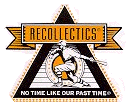
Media woes led to a unique collectible
ERIC BREIER
STAFF WRITER
While the Chicago Cubs were playing the Detroit Tigers in the 1908 World Series, many reporters were struggling to get a good view of the games.
The poor seating arrangement helped lead to one of the more unique World Series collectibles available to sports memorabilia enthusiasts.
Several reporters formed the Baseball Writer's Association of America because they were upset over the seat location for the 1908 World Series, won in five games by the Cubs. And that eventually led to the creation of the press pin.
In 1911, the Philadelphia Athletics became the first team to issue press pins to reporters covering the World Series. The pins provided access to the press box for media members while keeping out those who weren't working members of the press.
And 86 years later, journalists covering this year's World Series between the Florida Marlins and Cleveland Indians also will be issued press pins.
"Today it's more of a tradition," said Daniel Lovegrove, an expert on press pins. "You need more elaborate credentials."
Lovegrove is the owner of Recollectics, a sports memorabilia company based in Darien, Conn., that specializes in press pins of all types.
Although press pins don't serve as official credentials anymore, they're among the more unique World Series items available to collectors.
Programs and ticket stubs are two of the most popular World Series collectibles, but press pins are just as valuable, and often more SO.
The costliest and most difficult pins to find are the ones from 1911 through 1919, when a ribbon was attached to a medallion.
'Early ribbons are hard because finding them in excellent or mint condition is nearly iinpossible," said lovegrove, who sells press pins through the mail and through his Internet site (www.recollectics.com). "A lot of times the ribbon frays and becomes detached from the broach piece. It depends how they were taken care of?'
A mint 1911 Athletics press pin fists for $15,000 in the October issue of Beckett Vintage Sports. A mint 1919 Chicago White Sox pin, the year of the infamous Black Sox scandal, books for $10,000.
However, there is hope for the collector working with a more modest budget. Most pins from the late '50s to the present can be had for tinder $300. The 1984 Padres press pin is among the least expensive available, listing at $60 in Beckett.
Press pins have been produced every year for each participating team since 1912 with the exception of one -the 1918 Cubs.
"They had a very small press box;" Lovegrove said. "Maybe the finances were tight, who knows. They're the only team that has not :&sued a pin)."
Some World Series press pins for teams that don't make it to the Fall Classic are also available.
Near the end of each regular season, teams that have a shot at the postseason will produce pins in anticipation of a possible World Series appearance. Of course, many of these teams never make it that far, but that doesn't mean the pins - called phantom press pins aren't on the market.
Some of the more difficult phantom press pins to find, according to Lovegrove, are 1960 Baltimore, 1979 Houston, 1981 Cubs and 1974 Texas. However, phantom pins aren't as popular as some of the others,
"I don't get as many calls for phantom pins as World Series or All-Star," Lovegrove said. "I've been selling a lot of Super Bowl pins lately They seem to be catch mg on more and more. But I do sell a lot of World Series, All-Star and Hall of Fame pins!'
Pins were issued for All-Star games beginning in 1938. Pins also are issued for the Super Bowl, and baseball and football Hall of Fame ceremonies, among other sporting events. While non-World Series press pins are generally of similar high quality, that wasn't the case in at least one instance.
"The 1988 Cincinnati All-Star pin is real chintzy and very poor quality," Lovegrove said. "A lot of that is up to the owners. The owner of the Reds Marge Schott) ordered a pin that wasn't of the same quality It's hard to find, though. It came in a wrapper instead of a case.... She did make up for it in 1990 (when the Reds were in the World Series). She must have taken a lot of heat for '88."
The North County Times, Monday October 20, 1997.
Reprinted by Permission from The North County Times. (c) 1997 The North County Times.